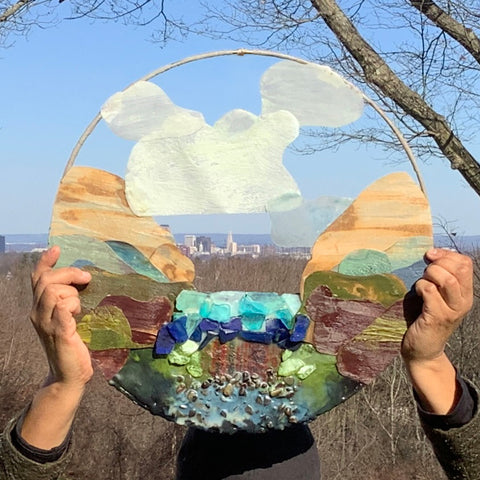Are we all-in?
Our entire human history is in the very soil beneath us. Our bodies, and all those that have come before us, are still here. We are part of this world.
Yet, we humans walk around every day at the center of existence. The streets are made for our cars, the buildings are made for the companies we work with, shop at, or visit—even the parks are made for our enjoyment. Our lives are dappled with reminders that this world of ours includes non-humans: squirrels (and pretty birds) snacking at the bird feeders, rats snagging pizza slices from the trash, eagles nesting outside of high-rise windows, and locally, bears strolling in the town center.
They are here—should we decide to stop and notice.
Imbued with human importance, we can look upon our world and invite, coexist with, or even destroy any non-human.
“Watch out, roaming bears, street opossums, pesky blue jays, and garden eating slugs!”
“Mowing you down, unruly milkweeds, scrawny goldenrods, and lawless Joe Pye weed!”
“No insects allowed this whole summer!”
We are masters of our domain.
Every day we have reminders of cultural traditions where we invite a bit of nature deeply into our lives. Sometimes these traditions are old, and sometimes they are newly created. Although we humans have been known to invite a tree into our living rooms from time to time, can we remember the forest?
What is this lens through which we are seeing our reality?
How have we let our human nature overlay Nature itself?
Part of our human superpower is to connect, on a grand scale, with each other. Philosophical, artistic, literary, and technological movements have all begun with a small spark that can drive entire systems to connect, be reinvigorated, or be challenged. What is next?
Our non-human neighbors have been here longer than all of mankind. We are, in the history of our planet earth, just newcomers.
This next phase may be the one where we deeply connect again with those whose language is too old. Hearing what the migrating birds are telling us —or what the clouds, oceans, or winds are communicating—are at the edges of our understanding. The very act of stopping to identify the being in front of us and asking ourselves, “What are you telling me?” can challenge our daily way of seeing.
Our human act of questioning is a force of nature.
Incorporating a regard for our natural systems in all our planning for building and construction with the goal of creating a beneficial existence with ALL our neighbors is a heritage we should claim.
The human landscape is vast. It can include soulless hardscape devoid of greenery, or permeable pathways full of flowering trees, birds, and all the beings that follow.
So, for your consideration: a new lens.
Identify our neighbors.
“I see you, Asclepius Tuberosa, favorite of the endearing Monarch and best location for laying eggs, snacking, and transforming caterpillar to butterfly. Thank you, beautiful pollinator, for helping my tiny garden and flowers to grow.”
“I see you, Mama Opossum, with all those babies snacking on crunchy ticks. My doggy thanks you, as do all our children.”
“I see you, American Bald Eagle, flying off with the rat from the waste bin behind the restaurant. Thank you, suburban raptor, for maintaining the balance of pests in our neighborhood.”
I see you. I invoke your name and now you are real.
And I am not alone.
We are together as allies, neighbors, and friends.
All-In
16 x 16
Vellum, rocks, glass, paper, encaustic wax on wire photographed with the skyline of Hartford, CT USA


Leave a comment
Please note, comments must be approved before they are published